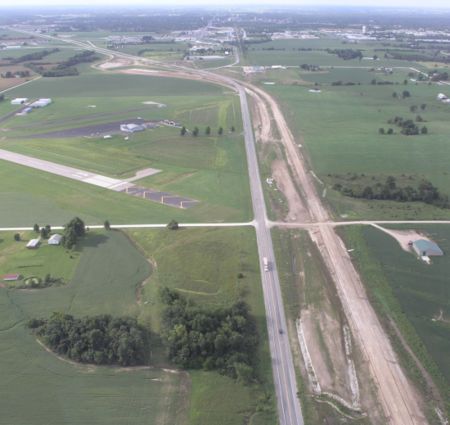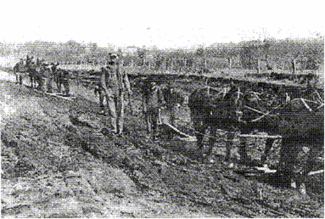Category:207 Linear Grading
Linear grading work is necessary to bring a roadway to the required grade and cross-section. The linear unit for measuring roadway excavation quantities is used when grading is expected to be minimal. Linear grading can be used on plans for all systems, however linear grading should not be used for roadways built with a constructed base.
There are many aspects to be considered when inspecting construction quality and this article provides construction inspection guidelines.
Contents
207.1 Class 1 Linear Grading
Class 1 Linear Grading excavates the topography to the roadway’s designated cross-section and approximately completes the nearby embankments with a minimum of drifting. Class I Linear Grading is used where it is not necessary to control the finished grade line for purposes other than to obtain minimum cover over culverts. Grades cannot be controlled except at culverts; therefore, profile grades are not shown on the plans. The estimated volume of the grading should be shown on the plans. If linear grading is used for construction of median crossovers or connections to driveways, a job special provision should be written to specify the contractor’s responsibilities for the job.
207.2 Class 2 Linear Grading
Class 2 consists of grading where it is necessary to excavate and haul material approximately 200 ft. to bring the roadway to the desired grade and may involve work on high banks and side hills. It is not the intent of this item to require the contractor to haul material across several hilltops or for unduly long distances. Grades can be controlled within 0.5 ft. Profile grades are indicated on the plans by a dashed line in the vicinity of culverts, at sight distance controls, and at any other locations where it is necessary or desirable that this grading be performed to a controlled grade. Otherwise, profile grades are not shown.
When specifying Linear Grading, Class 2, the designer should show the estimated volume (yd3) of material to be placed or removed on the Summary of Quantities 2B sheet. Though this class of grading is paid for in units of stations or meters, the volumetric estimates allow the contractor to more accurately bid this work.
207.3 Approaches
Linear Grading, Class 1 can be used as a unit of measurement for grading approaches on plans for all systems within the limits of Class 1 and Class 2 Linear Grading. Measurement will be made to the nearest 10 ft. for each facility and totaled to the nearest 100 ft. If grading quantities exceed Class 2 limits, Volume Grading is required and specified for approach construction. No attempt is made to adjust volume grading quantities where linear grading is used for grading approaches connecting to sections of the main roadway being graded by volume.
207.4 Classified Excavation
A limited quantity of excavation, such as Class C excavation, from the roadway can be paid for in addition to the linear grading in sections being graded by linear grading. In such cases, the plans indicate the quantity of classified excavation and a note is placed on the profile section of the plan-profile sheet to indicate the approximate location of the classified material. Undergrading cut is not usually specified where linear grading is used. Volume grading is used where it is necessary to undergrade cuts.
207.5 Inlet and Outlet Ditches
The construction of inlet and outlet ditches is included in the roadway linear grading if the excavation for the construction of the ditch does not exceed approximately 50 yd3 on either side. If the ditch excavation does exceed approximately 50 yd3, it is paid for by volume grading, and the quantities for the volume grading are indicated on the plans in addition to the linear grading quantities.
207.6 Plans
Linear grading is shown on the plans by class and units consistent with the units specified in the standard specifications. Linear grading quantities for grading approaches are shown separately on the plans, but are combined with other linear grading quantities in the estimate and contract. Examples are shown in Sample Plans.
207.7 Construction Inspection Guidelines for Sec 207
This work consists of grading work necessary to bring a roadway to required grade and cross-section, allowing reasonable tolerances for economic reasons. When performing Design field checks, consider the availability of material needed to complete the grade. The cost for the different methods for completing the grade should be reflective of the effort required.
Description (for Sec 207.1)
Linear grading is divided into two classes, based on amount of work necessary to complete the design template.
Linear Grading, Class 1 (for Sec 207.1.1). Class 1 Linear Grading consists of grading requiring a minimum of drifting or hauling, where it is not necessary to control the grade line very closely. Class I Linear Grading should be used when drifting material from the adjacent vicinity of the grade can complete the fill.
Linear Grading, Class 2 (for Sec 207.1.2). Class 2 Linear Grading is grading where it is necessary to excavate and haul material approximately 200 ft. or more to bring the roadway to a desired grade. Class 2 Linear Grading should be used when paddlewheels are needed to complete the grade. That distance is estimated to start at approximately 200 ft. If material isn't readily available and truck hauling is necessary, the work should be set up with excavation and embankment quantities.
Construction Requirements (for Sec 207.2)
Tolerances (for Sec 207.2.1). As specified.
Construction (for Sec 207.2.2). Each section of each type is established on the plans. During staking these sections should be checked and adjusted for any equations that might be found. The only stakes required for Class 1 Linear Grading are right-of-way, centerline, and structure stakes. Since profile grade is controlled for Class 2 Linear Grading, it is necessary to provide control elevations. This is usually done by marking cut or fill to grade on right of way stakes. Linear grading requires only minimal inspection on a random basis to assure that proper procedures are followed.
Obliterations (for Sec 207.2.3). As specified.
Subgrade (for Sec 207.2.4). As specified.
Method of Measurement (for Sec 207.3)
The class of linear grading will be designated on the plans. It is not subject to change during construction. Entrances and side roads must be measured as Class 1 Linear Grading. The staking record is sufficient documentation for measurement of Linear Grading sections to the nearest 1/10 station.
Basis of Payment (for Sec 207.4)
Payment for Linear Grading is per station. Each section of each type will be established on the plans. If excavation material which would be classified as other than Class A is encountered, the material will be measured in the usual manner and payment made on a yardage basis. This payment will be in addition to, not in lieu of, payment for linear grading.


